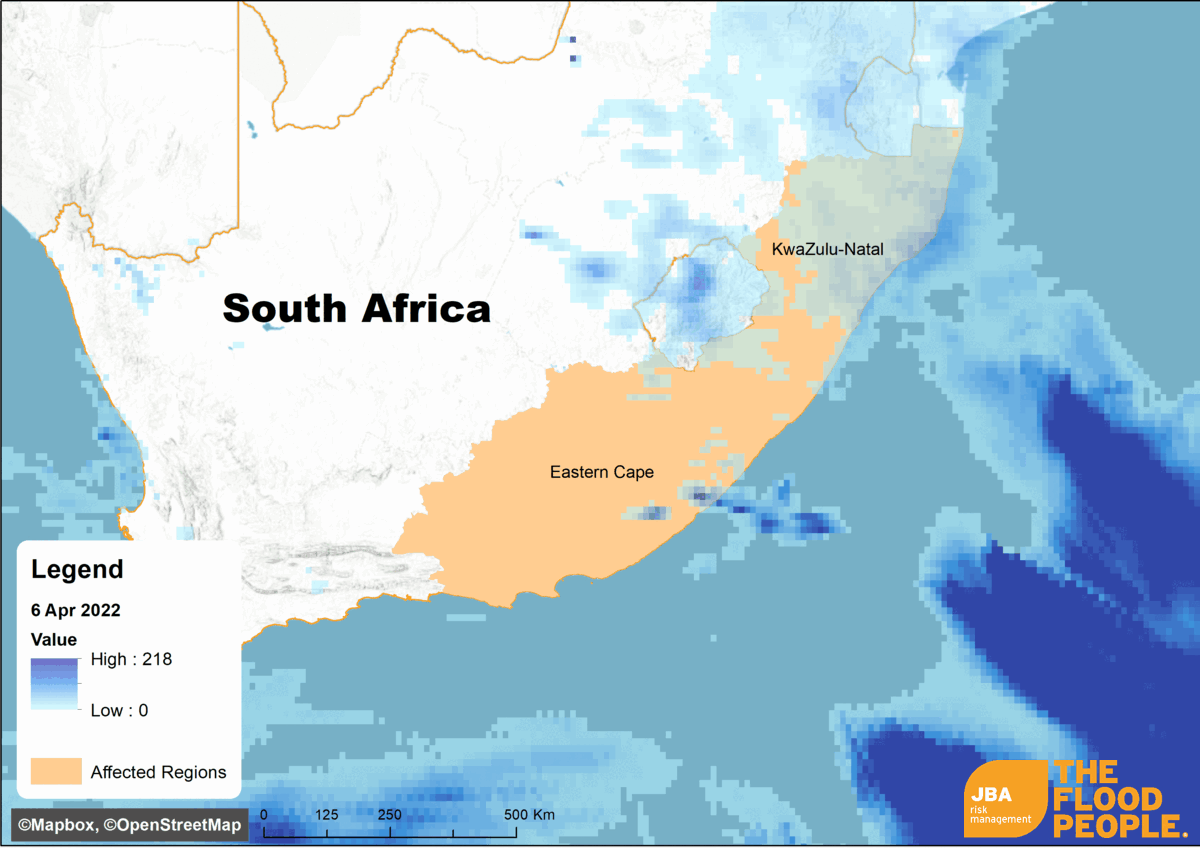Following severe flooding in Mozambique and Madagascar earlier in the year, further storms affected Durban and surrounding areas of South Africa in April 2022, causing over 400 fatalities.
Between 8 and 21 April 2022, the slow-moving storm Issa brought long periods of heavy rain to KwaZulu-Natal which caused flooding and mudslides in Durban and surrounding areas, affecting over 40,000 people and leaving a trail of destruction. The region has been declared a state of disaster by President Cyril Ramaphosa and many people were still without power or drinking water several days after the waters began to recede (AfricaNews, 2022).
More than 440 people are known to have died, with the search continuing for a further 63 people reported missing at the time of writing. Mudslides as well as swollen rivers were responsible for many of these deaths (BBC, 2022a). Search and rescue operations being run from Virginia Airport in Durban were still sending out teams on Sunday 24 April to search for missing people thought to have been swept away by the floods (Durban Mercury, 2022).
One factor exacerbating the effects of the storms was the fact that many homes in lower-income neighbourhoods of Durban – the worst affected city – are built on open, unsafe ground in low-lying areas, leaving low-income families particularly vulnerable to flooding and landslides (ABC News, 2022).
At least 13,000 homes have been damaged, and community spokespeople have said that poor drainage and building standards have increased the scale of the disaster (BBC, 2022b).
Other issues affecting the province following the flooding include damage to the water supply, with 80% of the drinking water network out of order according to authorities; over 600 schools facing disruption or temporary closures; roads becoming impassable, and bridges being swept away (CNN, 2022).
So far, R1 billion (USD $67 million) has been allocated by the South African government to help KwaZulu-Natal (KZN) respond to the floods, but local officials believe they will need at least twice that amount to complete their work in the region (Thesouthafrican.com, 2022a). The Premier of KZN, Sihle Zikalala has stated that more than R1.9 billion (USD $120 million) will be needed (Durban Mercury, 2022).
 The story of the kzn floods
The story of the kzn floods
A strong low pressure weather system off the east coast of southern Africa – in itself not an unusual occurrence, with such systems often causing localised flooding and large wave events in the autumn – brought rain to the region from 8 April 2022 (Thesouthafrican.com, 2022b).


Figure 1: Satellite observed rainfall animation over South Africa from 6 to 21 April 2022. Data source: NASA GPM, 2022 (video produced by JBA Risk Management, 2022).
The low pressure system was enhanced by an influx of low-level moist air feeding in from the southern Indian ocean. The airflow originated from a warmer sub-tropical climate, which increased the system’s capacity to hold moisture. The combined effects of additional heat and moisture enabled the system to produce more rainfall, exceeding the expectations of the southern African meteorological community (South African Weather Service, 2022).
The South African Weather Service issued a Level 5 warning for coastal areas and interior areas of KwaZulu-Natal, which was subsequently upgraded to Level 8 and then to Level 9, reflecting disruptive rainfall, widespread flooding, sinkholes, mudslides, and major traffic disruption (South African Weather Service, 2022).
Durban recorded 91mm of rain in 24 hours from 10-11 April, with more flooding occurring on 12 April in the wider area after more rain fell over the region. Margate, Sezela, Mount Edgecombe and parts of Durban all received more than 300mm of rain in the 24 hours to 12 April (Floodlist, 2022a). This is more than four times the average amount for the entire month of April (CNN, 2022).
Durban, a thriving port city, has experienced flooding events every year since 2016, but previous storms have typically dropped half this amount (100-150mm) in any 24-hour period (Thesouthafrican.com, 2022b).
Several rivers, including the Amanzimtoti, Umbilo and Umgeni, overflowed, causing widespread damage to informal settlements and other riverside communities (Floodlist, 2022b).
Financial losses
Flood-related claims of R245 million had been received by 14 April. About R45 million of the claims were from residential, motor and commercial policies. The remaining R200 million came from industrial policies covering plants, factories, equipment, and shipping and maritime policies (Daily Maverick, 2022). This is the biggest natural disaster affecting the insurance industry in South Africa since the 2017 Knysna fires which led to R7 billion in claims (Daily Maverick, 2022).
Previous large floods in this area
Durban Easter Floods 2019: 18-22 April 2019
There were over 85 fatalities in Eastern Cape and KwaZulu-Natal, and economic losses cost the KwaZulu-Natal Government USD $75 million and cost the Disaster Management Centre USD $45 million (WillisRe, 2019; France24, 2022; News24, 2019). The 2019 Durban Easter Floods were also caused by heavy rains due to a low pressure system (France24, 2022; News24, 2019).
South Africa floods 1987: 25-29 September 1987
Around 400 people were killed, and 50,000 left homeless in KwaZulu-Natal (Government of South Africa, 2022b). Informal settlements were wholly destroyed (Integrated Emergency Response, 2020). The total cost of damages to agriculture, communications, infrastructure and property was R400 million (Government of South Africa, 2022b). Floods were also caused by a low pressure system (Platford, 1988), resulting in high rainfall – some areas received up to 900mm of rain in four days (South Coast Sun, 2016). This is considered the most devastating flood in South Africa in history (Integrated Emergency Response, 2020).
How does climate change impact these events?
Following comments from South Africa’s President, the issue of climate change has been widely discussed in relation to this event. With the flooding coming hard on the heels of a season in which three tropical cyclones and two tropical storms hit south-east Africa in just six weeks, experts are highlighting similarities in the underlying causes of these extreme events (Guardian, 2022).
Scientists from several nations collaborating on research commissioned by the World Weather Attribution organisation have analysed how human-induced climate change affected the 3-day average annual maximum rainfall in the regions worst hit by Tropical Storms Ana and Batsirai in January-February 2022. Their conclusion that the region is expected to see increased likelihood and intensity of rainfall caused by tropical storms has led many commentators to link the KZN flooding to the season’s other storms (World Weather Attribution, 2022).
Experts at the South African Weather Service (SAWS) say severe and extreme weather events are becoming more frequent and intense as a result of the changing climate (BBC, 2022c).
However, poor infrastructure, urban sprawl and a lack of resources have also been blamed for the severe effects of the floods (BBC, 2022c), with many of the homes affected being flimsily built and lacking adequate drainage systems which mean that they offer little protection from the elements (Guardian, 2022).
JBA’s southern Africa focus
With increasing interest in our flood maps and probabilistic models from re/insurers and Disaster Risk Reduction organisations active in this region, JBA is working with new partners in the area.
We have recently partnered with Reinsurance Solutions Intermediary Services (RSIS), an African based reinsurance broker who will use JBA’s global flood modelling capability to provide flood risk analytics and catastrophe modelling services for its insurance clients across Africa.
Flood risk is a significant peril in the continent, especially in eastern and southern regions, with the 2020 East Africa floods affecting at least 700,000 people and the 2019 Easter floods in South Africa causing R650 million (USD $40 million) worth of storm damage.
"Flood risk is a peril that is often overlooked in Africa but can be extremely costly when it is not taken into account. We are proud to partner with JBA Risk Management, global leader in flood risk. Their outstanding analytics and insights complement our comprehensive service offering, ensuring our clients are fully informed and have a more complete understanding of the cover that they require. We believe in partnering with the right people, and this is one such partnership." - Thato Raboroko, RSIS Head of Analytics.
Get in Touch
It is vital that organisations act now to understand both current and future flood risk. As well as offering probabilistic models and high-resolution river and surface water hazard maps for all countries globally, JBA enables organisations to understand their risk to flood through the delivery of bespoke flood assessment reports and portfolio analysis. For more information, get in touch with the team at JBA.
This report is covered by JBA’s website terms – please read them here.
References
ABC News, 2022. South Africa’s Durban still recovering from deadly floods. [online] Available at: https://abcnews.go.com/International/wireStory/south-africas-durban-recovering-deadly-floods-84260585 [Accessed 26 April 2022]
AfricaNews, 2022. As South Africa flood toll nears 400, rescuers continue search for missing. [online] Available at: https://www.africanews.com/2022/04/16/as-south-africa-flood-toll-nears-400-rescuers-continue-search-for-missing/ [Accessed 26 April 2022]
BBC, 2022a. KwaZulu-Natal floods: South Africa army sends 10,000 troops. [online] Available at: https://www.bbc.co.uk/news/world-africa-61113807 [Accessed 26 April 2022]
BBC, 2022b. Durban flood survivors: South Africans homeless, hurt and heartbroken. [online] Available at: https://www.bbc.co.uk/news/world-africa-61105463 [Accessed 26 April 2022]
BBC, 2022c. Durban floods: Is it a consequence of climate change? [online] Available at: https://www.bbc.co.uk/news/61107685 [Accessed 26 April 2022]
CNN, 2022. South Africa flooding: over 300 killed after flooding washed away roads, destroyed homes in South Africa. [online] Available at: https://edition.cnn.com/2022/04/13/africa/south-africa-rain-floods-climate-intl/index.html [Accessed 26 April 2022]
Daily Maverick, 2022. SA insurance industry drowning in claims after KZN flash floods, Covid-19 and July riots. [online] Available at: https://www.dailymaverick.co.za/article/2022-04-24-sa-insurance-industry-drowning-in-claims-after-kzn-flash-floods-covid-19-and-july-riots/ [Accessed 26 April 2022]
Durban Mercury (IOL), 2022. Cost of KZN flood disaster escalates. [online] Available at: https://www.iol.co.za/dailynews/news/kwazulu-natal/cost-of-kzn-flood-disaster-escalates-bcffc014-7be6-4e4f-a976-6b35f84ae6f1 [Accessed 26 April 2022]
Floodlist, 2022a. South Africa – Heavy Rain Causes Floods and Mudslides in KwaZulu-Natal. [online] Available at: https://floodlist.com/africa/south-africa-floods-mudslides-kwazulu-natal-april-2022 [Accessed 26 April 2022]
Floodlist, 2022b. Death Toll in KwaZulu-Natal Floods Over 300. [online] Available at: https://floodlist.com/africa/south-africa-kwazulu-natal-floods-april-2022 [Accessed 26 April 2022]
France24, 2022. What's behind South Africa's flood disaster? [online] Available at: https://www.france24.com/en/live-news/20220418-what-s-behind-south-africa-s-flood-disaster [Accessed 27 April 2022]
Government of South Africa, 2022b. Remarks by Premier of Kwazulu-Natal Sihle Zikalala on prayer held in memory of the victims of recent floods. [online] Available at: https://www.gov.za/speeches/remarks-premier-kwazulu-natal-sihle-zikalala-prayer-held-memory-victims-recent-floods-21 [Accessed 27 April 2022]
Guardian, 2022. After the relentless rain, South Africa sounds the alarm on the climate crisis. [online] Available at: https://www.theguardian.com/world/2022/apr/24/south-africa-floods-rain-climate-crisis-extreme-weather [Accessed 26 April 2022]
Integrated Emergency Response, 2020. The worst South African floods. [online] Available at: https://www.ier.co.za/the-worst-south-african-floods/ [Accessed 27 April 2022]
News24, 2019. KZN floods: Death toll up to 85. [online] Available at: https://www.news24.com/News24/kzn-flooding-death-toll-up-to-85-20190425 [Accessed 27 April 2022]
Platford, G. G. (1988). Protection against flood damage. Proceedings of South Africa Sugar Technologists’ Association.
The South African, 2022a. KZN floods: Nearly R2 billion NEEDED ‘to complete our work’ - Zikalala. [online] Available at: https://www.thesouthafrican.com/news/kzn-floods-nearly-r2-billion-needed-to-complete-our-work-zikalala/ [Accessed 26 April 2022]
The South African, 2022b. Warnings for floods in SA: Planning for future climate change. [online] Available at: https://www.thesouthafrican.com/lifestyle/environment/flooding-weather-forecast-systems-kzn-floods/ [Accessed 26 April 2022]
South African Weather Service, 2022. Extreme rainfall and widespread flooding overnight: KwaZulu-Natal and parts of Eastern Cape. [online] Available at: http://www.weathersa.co.za/Documents/Corporate/Medrel12April2022_12042022142120.pdf [Accessed 27 April 2022]
South Coast Sun, 2016. A river ran through it. [online] Available at: https://southcoastsun.co.za/81662/a-river-ran-through-it/ [Accessed 27 April 2022]
WillisRe, 2019. Summary of Natural Catastrophe Events 2019. [online] Available at: https://www.willistowerswatson.com/-/media/WTW/Insights/2020/01/Willis-Re-Summary-of-Natural-Catastrophe-Events-2019.pdf?modified=20200128113240 [Accessed 27 April 2022]
World Weather Attribution, 2022. Climate change increased rainfall associated with tropical cyclones hitting highly vulnerable communities in Madagascar, Mozambique and Malawi. [online] Available at: https://www.worldweatherattribution.org/climate-change-increased-rainfall-associated-with-tropical-cyclones-hitting-highly-vulnerable-communities-in-madagascar-mozambique-malawi/ [Accessed 26 April 2022]
